2016 PEUGEOT 3008 weight
[x] Cancel search: weightPage 237 of 344
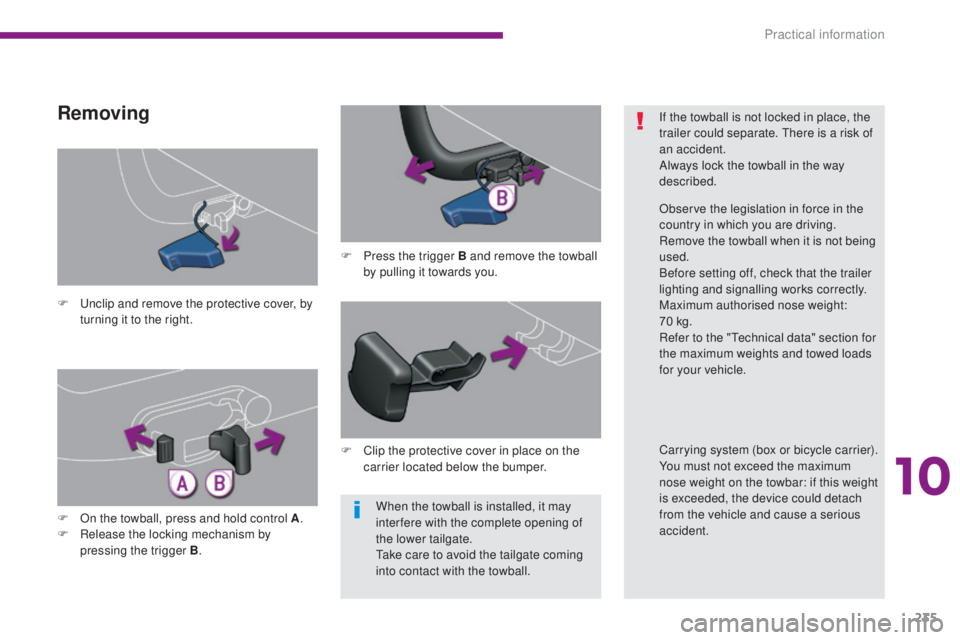
235
3008_en_Chap10_infos-pratiques_ed01-2015
When the towball is installed, it may
inter fere with the complete opening of
the lower tailgate.
Take care to avoid the tailgate coming
into contact with the towball.
F
U
nclip and remove the protective cover, by
turning it to the right.
Removing
F Press the trigger B and remove the towball by pulling it towards you.
F
O
n the towball, press and hold control A .
F
R
elease the locking mechanism by
pressing the trigger B . F
C
lip the protective cover in place on the
carrier located below the bumper. If the towball is not locked in place, the
trailer could separate. There is a risk of
an accident.
Always lock the towball in the way
described.
Observe the legislation in force in the
country in which you are driving.
Remove the towball when it is not being
used.
Before setting off, check that the trailer
lighting and signalling works correctly.
Maximum authorised nose weight:
70
kg.
Refer to the "Technical data" section for
the maximum weights and towed loads
for your vehicle.
Carrying system (box or bicycle carrier).
You must not exceed the maximum
nose weight on the towbar: if this weight
is exceeded, the device could detach
from the vehicle and cause a serious
accident.
10
Practical information
Page 238 of 344
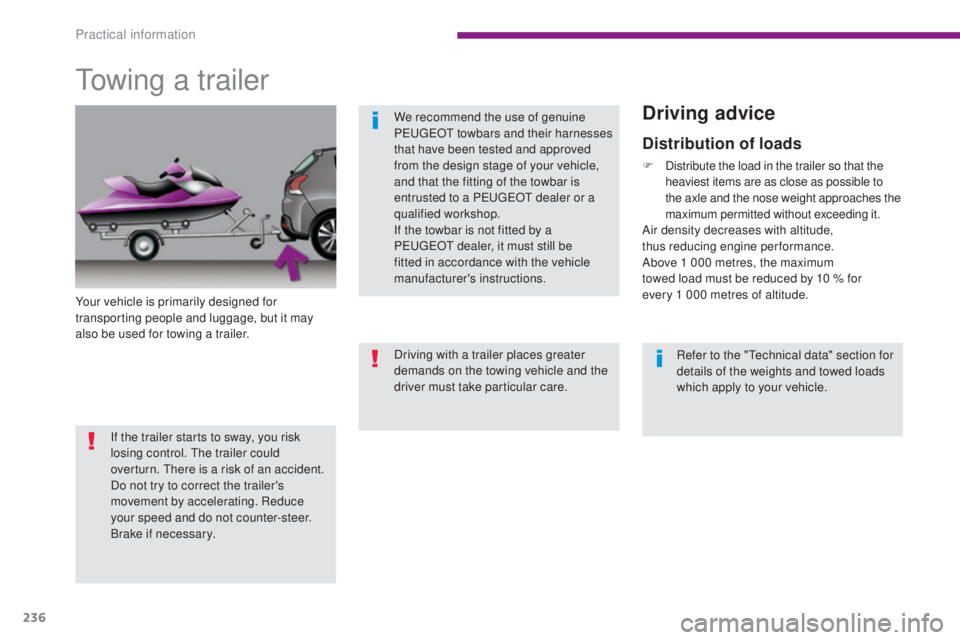
236
3008_en_Chap10_infos-pratiques_ed01-2015
Towing a trailer
Your vehicle is primarily designed for
transporting people and luggage, but it may
also be used for towing a trailer.Refer to the "Technical data" section for
details of the weights and towed loads
which apply to your vehicle.
We recommend the use of genuine
PEUGEOT towbars and their harnesses
that have been tested and approved
from the design stage of your vehicle,
and that the fitting of the towbar is
entrusted to a PEUGEOT dealer or a
qualified workshop.
If the towbar is not fitted by a
PEUGEOT dealer, it must still be
fitted in accordance with the vehicle
manufacturer's instructions.
Driving with a trailer places greater
demands on the towing vehicle and the
driver must take particular care.
If the trailer starts to sway, you risk
losing control. The trailer could
overturn. There is a risk of an accident.
Do not try to correct the trailer's
movement by accelerating. Reduce
your speed and do not counter-steer.
Brake if necessary.
Driving advice
Distribution of loads
F Distribute the load in the trailer so that the heaviest items are as close as possible to
the axle and the nose weight approaches the
maximum permitted without exceeding it.
Air density decreases with altitude,
thus reducing engine performance.
Above
1 000 metres, the maximum
towed load must be reduced by 10
% for
every
1 000 metres of altitude.
Practical information
Page 240 of 344
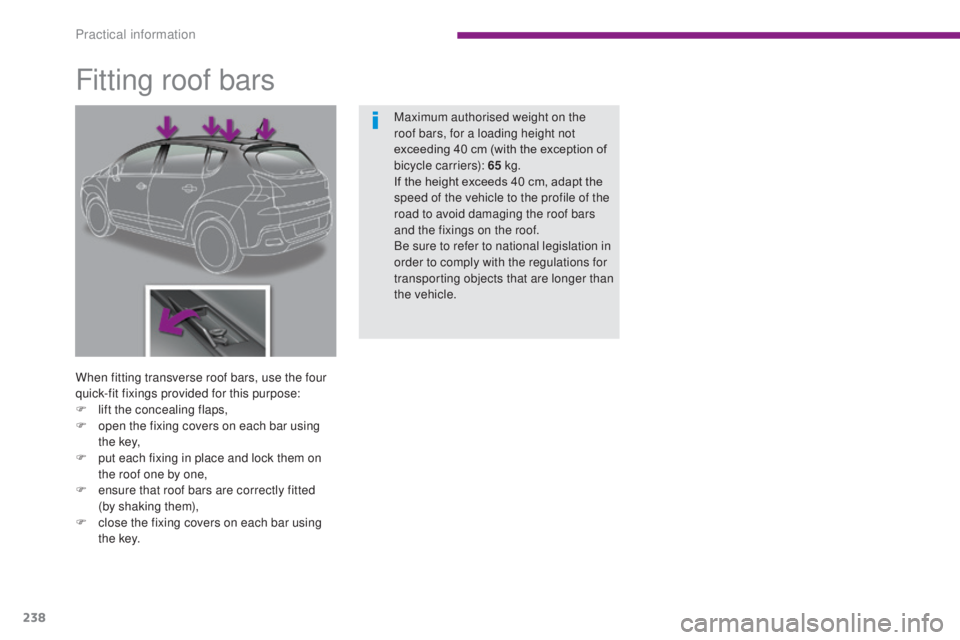
238
3008_en_Chap10_infos-pratiques_ed01-2015
Fitting roof bars
When fitting transverse roof bars, use the four
quick-fit fixings provided for this purpose:
F
l
ift the concealing flaps,
F
o
pen the fixing covers on each bar using
t h e key,
F
p
ut each fixing in place and lock them on
the roof one by one,
F
e
nsure that roof bars are correctly fitted
(by
shaking them),
F
c
lose the fixing covers on each bar using
t h e key. Maximum authorised weight on the
roof bars, for a loading height not
exceeding
40 cm (with the exception of
bicycle carriers): 65 kg.
If the height exceeds 40 cm, adapt the
speed of the vehicle to the profile of the
road to avoid damaging the roof bars
and the fixings on the roof.
Be sure to refer to national legislation in
order to comply with the regulations for
transporting objects that are longer than
the vehicle.
Practical information
Page 245 of 344
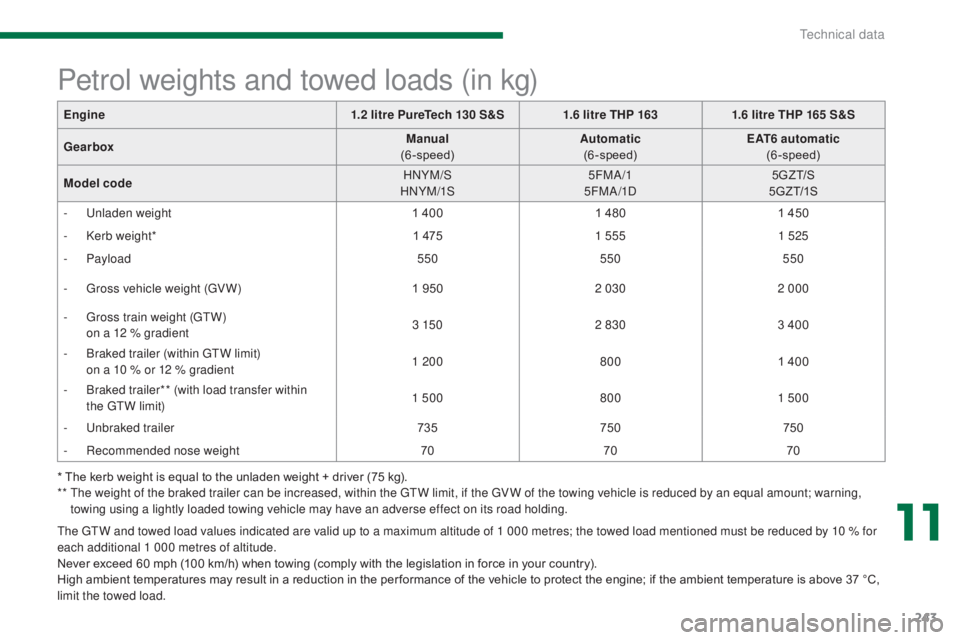
243
3008_en_Chap11_caracteristiques_ed01-2015
* The kerb weight is equal to the unladen weight + driver (75 kg).
** T he weight of the braked trailer can be increased, within the GTW limit, if the GV W of the towing vehicle is reduced by an equal amount; warning,
towing using a lightly loaded towing vehicle may have an adverse effect on its road holding.
Petrol weights and towed loads (in kg)
The GTW and towed load values indicated are valid up to a maximum altitude of 1 000 metres; the towed load mentioned must be reduced by 10 % for
each additional 1 000 metres of altitude.
Never exceed 60 mph (100 km/h) when towing (comply with the legislation in force in your country).
High ambient temperatures may result in a reduction in the per formance of the vehicle to protect the engine; if the ambient temperature is above 37 °C,
limit the towed load. Engine
1.2 litre PureTech 130 S&S 1.6 litre THP 163 1.6 litre THP 165 S&S
Gearbox Manual
(6-speed) Automatic
(6-speed) EAT6 automatic
(6-speed)
Model code HNYM/S
HNYM/1S 5FMA /1
5FM A /1D 5G Z T/S
5G Z T/1S
-
U
nladen weight
1 4001 4801 450
-
K
erb weight*
1 4751 555 1 525
-
Payload
550550550
-
G
ross vehicle weight (GV W)
1 9502 0302 000
-
G
ross train weight (GTW)
o
n a 12 % gradient
3 150
2 830 3 400
-
B
raked trailer (within GTW limit)
o
n a 10 % or 12 % gradient
1 200
8001 400
-
B
raked trailer** (with load transfer within
the GTW limit)
1 500
8001 500
-
U
nbraked trailer
735750750
-
R
ecommended nose weight
707070
11
Technical data
Page 246 of 344
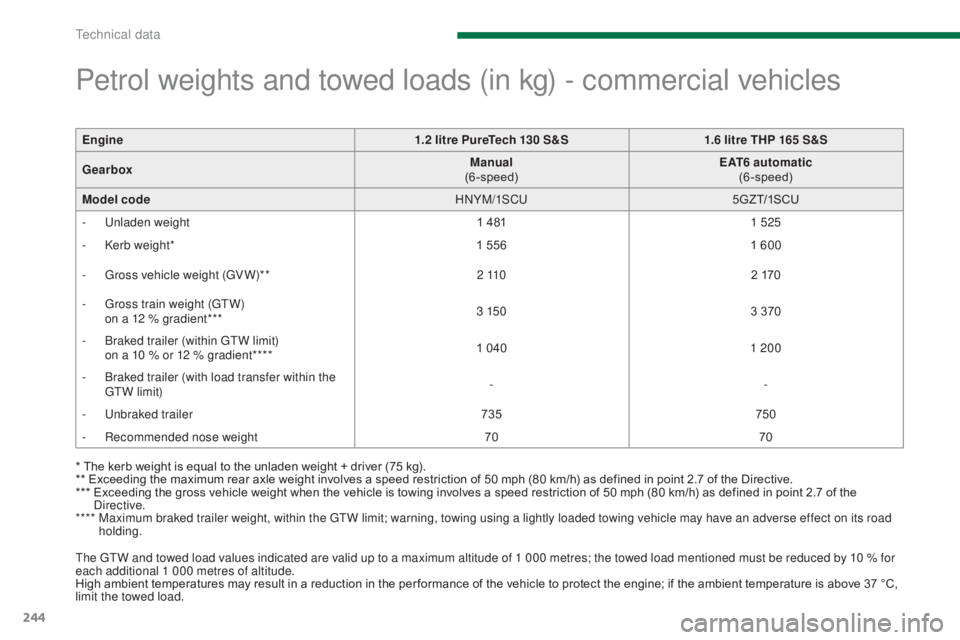
244
3008_en_Chap11_caracteristiques_ed01-2015
Petrol weights and towed loads (in kg) - commercial vehicles
* The kerb weight is equal to the unladen weight + driver (75 kg).
** Exceeding the maximum rear axle weight involves a speed restriction of 50 mph (80 km/h) as defined in point 2.7 of the Directive.
***
E
xceeding the gross vehicle weight when the vehicle is towing involves a speed restriction of 50 mph (80 km/h) as defined in point 2.7 of the
Directive.
****
M
aximum braked trailer weight, within the GTW limit; warning, towing using a lightly loaded towing vehicle may have an adverse effect on its road
holding.
The GTW and towed load values indicated are valid up to a maximum altitude of 1 000 metres; the towed load mentioned must be reduced by 10 % for
each additional 1 000 metres of altitude.
High ambient temperatures may result in a reduction in the per formance of the vehicle to protect the engine; if the ambient temperature is above 37 °C,
limit the towed load. Engine
1.2 litre PureTech 130 S&S1.6 litre THP 165 S&S
Gearbox Manual
(6-speed) EAT6 automatic
(6-speed)
Model code HNYM/1SCU5G Z T/1SCU
-
U
nladen weight
1 4811 525
-
K
erb weight*
1 5561 600
-
G
ross vehicle weight (GV W)**
2 11 02 170
-
G
ross train weight (GTW)
o
n a 12 % gradient***
3 150
3 370
-
B
raked trailer (within GTW limit)
o
n a 10 % or 12 % gradient****
1 040
1 200
-
B
raked trailer (with load transfer within the
GTW limit) -
-
-
U
nbraked trailer
735750
-
R
ecommended nose weight
7070
Technical data
Page 249 of 344
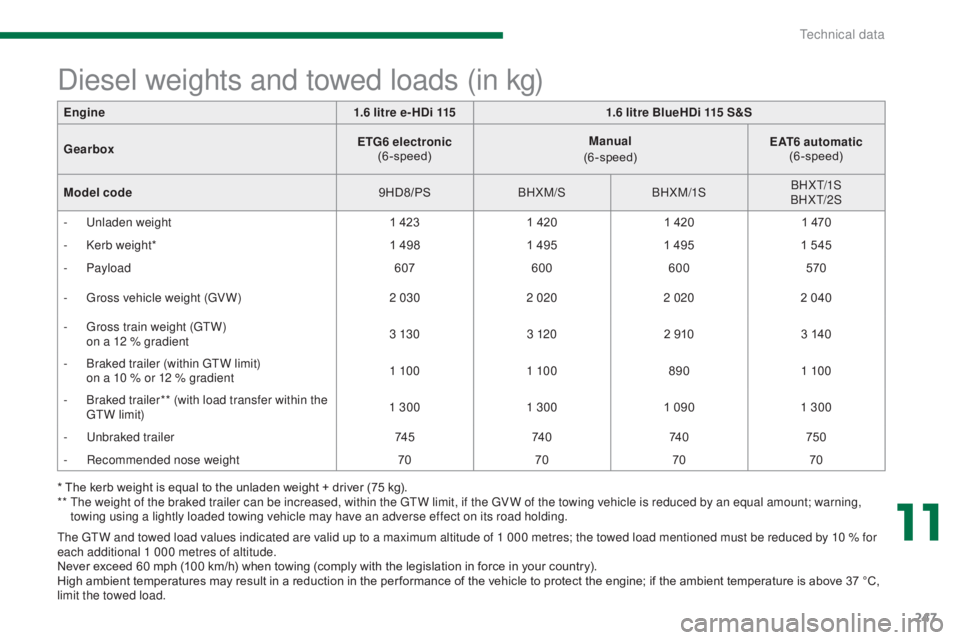
247
3008_en_Chap11_caracteristiques_ed01-2015
* The kerb weight is equal to the unladen weight + driver (75 kg).
** T he weight of the braked trailer can be increased, within the GTW limit, if the GV W of the towing vehicle is reduced by an equal amount; warning,
towing using a lightly loaded towing vehicle may have an adverse effect on its road holding.
Diesel weights and towed loads (in kg)
The GTW and towed load values indicated are valid up to a maximum altitude of 1 000 metres; the towed load mentioned must be reduced by 10 % for
each additional 1 000 metres of altitude.
Never exceed 60 mph (100 km/h) when towing (comply with the legislation in force in your country).
High ambient temperatures may result in a reduction in the per formance of the vehicle to protect the engine; if the ambient temperature is above 37 °C,
limit the towed load. Engine
1.6 litre e- HDi 1151.6 litre BlueHDi 115 S&S
Gearbox ETG6 electronic
(6-speed) Manual
(6-speed) EAT6 automatic
(6-speed)
Model code 9HD8/PSBHXM/SBHXM/1S BH X T/1S
BH X T/2S
-
U
nladen weight
1 4231 4201 420 1 470
-
K
erb weight*
1 4981 4951 4951 545
-
Payload
607600 600 570
-
G
ross vehicle weight (GV W)
2 0302 0202 0202 040
-
G
ross train weight (GTW)
o
n a 12 % gradient
3 13 0
3 1202 9103 140
-
B
raked trailer (within GTW limit)
o
n a 10 % or 12 % gradient
1 10 0
1 10 0 8901 10 0
-
B
raked trailer** (with load transfer within the
GTW limit) 1 300
1 3001 090 1 300
-
U
nbraked trailer
74 574 074 0750
-
R
ecommended nose weight
70707070
11
Technical data
Page 250 of 344
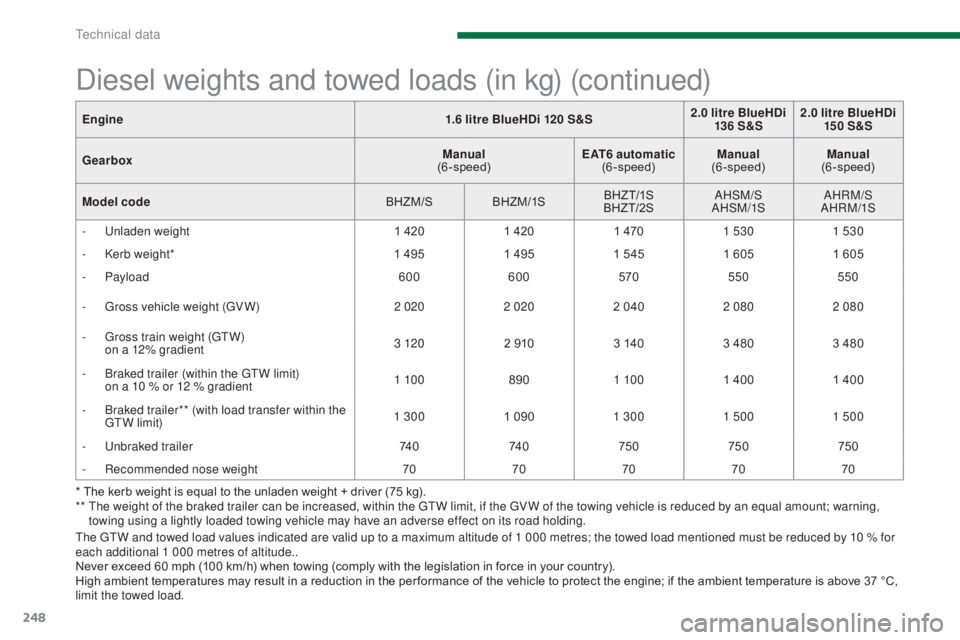
248
3008_en_Chap11_caracteristiques_ed01-2015
Diesel weights and towed loads (in kg) (continued)
* The kerb weight is equal to the unladen weight + driver (75 kg).
** T he weight of the braked trailer can be increased, within the GTW limit, if the GV W of the towing vehicle is reduced by an equal amount; warning,
towing using a lightly loaded towing vehicle may have an adverse effect on its road holding.
The GTW and towed load values indicated are valid up to a maximum altitude of 1 000 metres; the towed load mentioned must be reduced by 10 % for
each additional 1 000 metres of altitude..
Never exceed 60 mph (100 km/h) when towing (comply with the legislation in force in your country).
High ambient temperatures may result in a reduction in the per formance of the vehicle to protect the engine; if the ambient temperature is above 37 °C,
limit the towed load. Engine
1.6 litre BlueHDi 120 S&S2.0 litre BlueHDi
136 S&S 2.0 litre BlueHDi
15 0 S&S
Gearbox Manual
(6-speed) EAT6 automatic
(6-speed) Manual
(6-speed) Manual
(6-speed)
Model code BHZM/SBHZM /1S BHZ T/1S
BHZ T/2S AHSM/S
AHSM/1S AHRM/S
AHRM/1S
-
U
nladen weight
1 4201 420 1 4701 530 1 530
-
K
erb weight*
1 4951 4951 545 1 6051 605
-
Payload
600600 570550 550
-
G
ross vehicle weight (GV W)
2 0202 0202 040 2 080 2 080
-
G
ross train weight (GTW)
o
n a 12% gradient
3 120
2 9103 1403 480 3 480
-
B
raked trailer (within the GTW limit)
o
n a 10 % or 12 % gradient
1 10 0
8901 10 0 1 400 1 400
-
B
raked trailer** (with load transfer within the
GTW limit) 1 300
1 090 1 300 1 5001 500
-
U
nbraked trailer
74 074 0750 750750
-
R
ecommended nose weight
7070707070
Technical data
Page 251 of 344
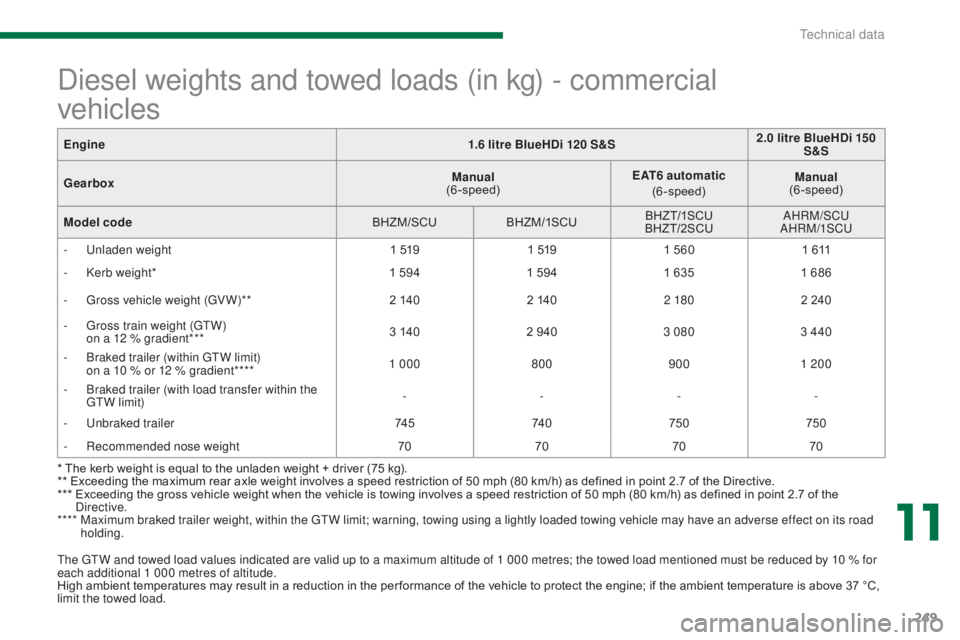
249
3008_en_Chap11_caracteristiques_ed01-2015
The GTW and towed load values indicated are valid up to a maximum altitude of 1 000 metres; the towed load mentioned must be reduced by 10 % for
each additional 1 000 metres of altitude.
High ambient temperatures may result in a reduction in the per formance of the vehicle to protect the engine; if the ambient temperature is above 37 °C,
limit the towed load.
Diesel weights and towed loads (in kg) - commercial
vehicles
* The kerb weight is equal to the unladen weight + driver (75 kg).
** Exceeding the maximum rear axle weight involves a speed restriction of 50 mph (80 km/h) as defined in point 2.7 of the Directive.
***
E
xceeding the gross vehicle weight when the vehicle is towing involves a speed restriction of 50 mph (80 km/h) as defined in point 2.7 of the
Directive.
****
M
aximum braked trailer weight, within the GTW limit; warning, towing using a lightly loaded towing vehicle may have an adverse effect on its road
holding.
Engine
1.6 litre BlueHDi 120 S&S 2.0 litre BlueHDi 150
S&S
Gearbox Manual
(6-speed) E AT 6
automatic
(6-speed) Manual
(6-speed)
Model code BHZM/SCUBHZM/1SCU BHZ T/1SCU
BHZT/2SCU AHRM/SCU
AHRM/1SCU
-
U
nladen weight
1 5191 5191 560 1 611
-
K
erb weight*
1 5941 594 1 6351 686
-
G
ross vehicle weight (GV W)**
2 1402 1402 180 2 240
-
G
ross train weight (GTW)
o
n a 12 % gradient***
3 140
2 940 3 080 3 440
-
B
raked trailer (within GTW limit)
o
n a 10 % or 12 % gradient****
1 000
8009001 200
-
B
raked trailer (with load transfer within the
GTW limit) -
---
-
U
nbraked trailer
74 574 0750 750
-
R
ecommended nose weight
70707070
11
Technical data